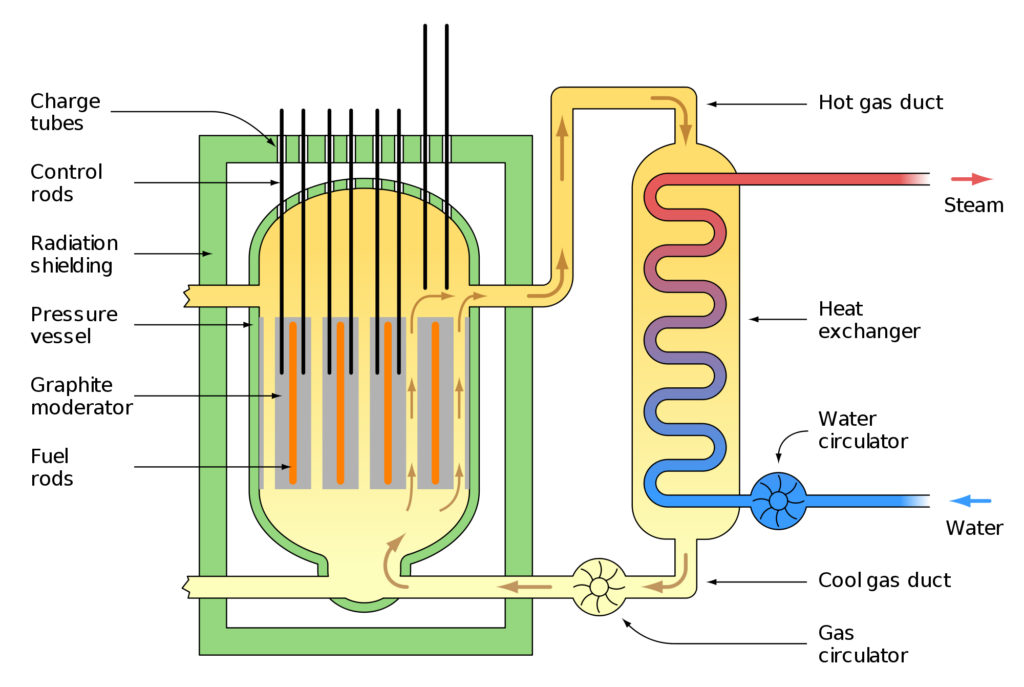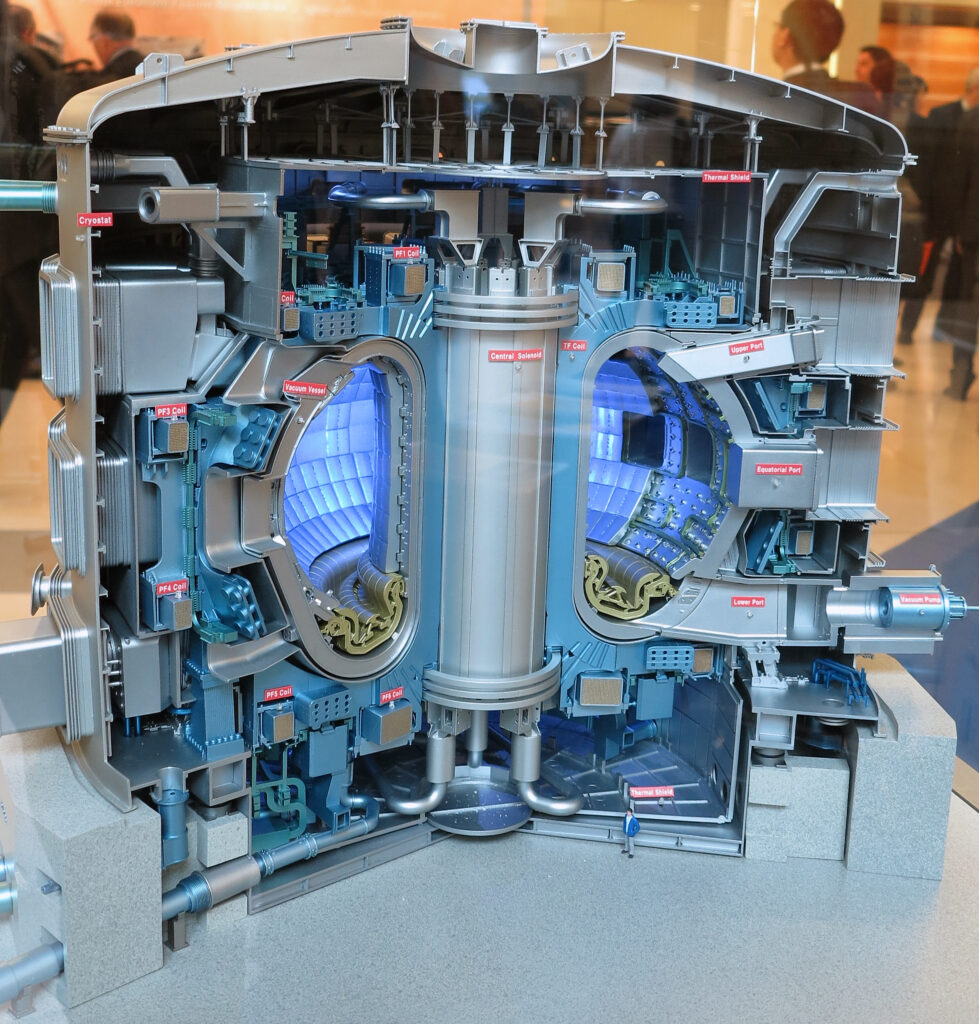9.5 Nuclear Energy
Nuclear energy is the energy that is stored in the nuclei of atoms; it comes in two types. Fission energy is released when large atoms like uranium split apart into smaller atoms. This is constantly taking place within the Earth—and it is part of the source of geothermal energy—and all around us, but the rate is very slow. We can build devices that increase that rate enough to generate heat in a controlled way, but there are some downsides to the technology.
Fusion energy is released when small atoms like hydrogen are fused together to make larger atoms. This is what is happening inside the sun, so we use that energy all of the time. We can reproduce nuclear fusion here on Earth in in the form of a hydrogen bomb, but that technology doesn’t allow for a controlled rate of energy release. Over the past several decades governments of several countries have spent tens of billions on research into controllable nuclear fusion. Fifty years ago, commercial nuclear fusion was considered to be less than fifty years away. During that time significant progress has been made in understanding what is needed to make that happen, but in 2021, it is still likely that a proof of the concept of fusion energy production is 5 to 10 years away, and that a fusion energy industry is likely another 25 years beyond that.
Nuclear Fission
Nuclear fission has been used for generating electricity since the late 1950s and there are currently around 440 fission reactors operating in 30 countries, producing about 10% of the world’s electricity. In a few countries, including France, Slovakia and Ukraine nuclear fission makes up more than 50% of electricity generation[1].
While naturally occurring uranium in rock splits apart only very slowly, the rate of fission is accelerated many thousands of times in a fission reactor because the uranium is highly concentrated, and the fuel is packed close enough together so that the neutrons released by one fission event will almost immediately trigger another fission in a nuclear chain reaction. An important point is that the chain reaction process must be carefully controlled by substances called moderators and, in the event of some irregularity, the reaction can be slowed relatively quickly by inserting control rods that inhibit the chain reaction process. It is important to realize that although a fission reactor can be dramatically slowed by inserting the control rods, the massive reactor core will still remain very hot for several days. This residual heat has been the cause of several nuclear accidents. A diagram of a type of fission reactor is provided on Figure 9.5.1, and the important components are described.

Modern nuclear reactors have many levels of protection against irregular operating conditions and against more significant failure and out-of-control behaviour. While that might give us some comfort, it cannot be denied that there have been some major failures in the nuclear power industry, at least one of which has had significant human and environmental implications. Three such failures are described in Box 9.1. Each of these led to a loss of public confidence in the safety of nuclear power, and to reductions in the number of reactors ordered and constructed in subsequent years.
Box 9.2 Nuclear Fission Plant Failures
Three significant nuclear plant failures—Three Mile Island (Pennsylvania), Chernobyl (Ukraine) and Fukushima (Japan)—have shaped the public’s perception of the safety of the nuclear industry, and have also informed the industry’s efforts to make nuclear reactors as safe as possible.

The Three Mile Island accident in March 1979 involved an operator error, the failure of a cooling system valve and the failure of the system that was meant to warn the operators of the valve’s malfunction. This led to a loss of coolant within the reactor vessel and resulted in partial melting of the nuclear fuel. There were high levels of radioactivity within the plant, and some radioactive materials were released into the environment via steam. Health officials eventually concluded that there were no deaths or significant illnesses that could be attributed to the accident, however that conclusion was controversial at the time, and remains so in the minds of many people.
The Chernobyl accident of April 1986 also involved an operator error and a system failure that resulted in the reactor power level increasing when it should have been decreasing (Figure 9.5.2). This led to a steam explosion that ruptured the reactor core and triggered an open-air reactor fire that continued for 9 days, releasing airborne radioactive material into the environment. A total of 28 plant workers and firefighters died within several days of the accident.[2] A 2006 United Nations report concluded that as many as 4000 cancer deaths are likely to occur amongst 5 million residents in the contaminated region around the plant over the 80 years following the accident, and that this represents a 0.3% increase over expected cancer deaths for that region.[3]
The Fukushima accident of March 2011 was the direct result of a magnitude 9 earthquake and a subsequent tsunami. Although none of the reactors was damaged by the earthquake, they were automatically shut down when the earthquake struck and therefore could not provide power to the cooling systems. Six external power supply systems failed because of the earthquake and although an emergency diesel power plant continued to supply power to cooling pumps, this was destroyed 50 minutes later by the 15 metre-high tsunami that overtopped protective barriers and inundated the plant. The result was that there was no cooling available for the still-hot reactors, three of which suffered melting within the reactor cores. No deaths have been attributed to the Fukushima accident, and although it is estimated that approximately 130 deaths may eventually occur because of elevated cancer rates , that number is small compared with the number of expected cancer deaths from other causes.
In a typical reactor the fuel elements will last for 18 months to a few years. Some types of reactors can be refuelled while still operating, but most have to be shut down for periods of up to several weeks. The spent fuel is removed and replaced with fresh fuel. The highly radioactive spent fuel is stored in swimming-pool sized tanks at the reactor site for about 5 years, and then is transferred to dry storage facilities, which are also on-site in most cases. On-surface storage of nuclear waste is not a viable option because the materials remain radioactive for thousands of years and represent both a health risk and security risk (from the perspective of nuclear proliferation). Several countries, including Canada and the United States, have conducted research into the deep underground storage of nuclear waste, but as of 2021, only Finland has an operating long-term storage facility.
Although the waste from nuclear fission is a serious problem, the volumes are not huge. The amount of radioactive waste produced for a person who used nuclear energy for their lifetime supply of electricity is about 3 kg. Nuclear fuel is quite heavy, so that amount would likely fit within a coffee cup.
Nuclear Fusion
Nuclear fusion can be achieved when hydrogen nuclei are forced close enough together to allow them to fuse together. The advantage of nuclear fusion for electricity generation is that it’s fuel (hydrogen) is abundantly available and it doesn’t produce significant amounts of toxic or radioactive waste. Nuclear fusion has the potential to produce energy from fuel that is virtually inexhaustible, without producing a significant amount of waste, but the process of achieving it is extremely complex, requires large amounts of energy to initiate the process, and extremely high temperatures (in the order of 100,000,000° C). These conditions, and the existence of lots of fast-moving neutrons, have possible implications for the mechanism that are still poorly understood.
The most advanced nuclear fusion project is ITER (International Thermonuclear Experimental Reactor) which has been under construction in southern France since 2008 and is expected to be complete by 2025 (Figure 9.5.3). This project is funded by the European Union, China, India, Japan, Russia, South Korea and the United States.

ITER will not be used to produce any electricity, but it is expected to be able to generate about 10 times more energy than the amount needed for its operation. It is estimated that the total construction and operating cost of ITER will be in the region of $65 billion.
The follow-up to ITER is called DEMO (DEMOnstration Power Station). It is currently being planned by the EUROfusion consortium, but is unlikely to be ready to operate until 2050. Although DEMO is intended to produce electricity that will be fed into the grid, it will not be a commercially operating power station.
In summary, while nuclear fusion could provide abundant energy without significant waste products or climate implications, its development has been and will continue to be extremely expensive and its realization is still at least 30 years away, probably more than that.
Media Attributions
- Figure 9.5.1 Magnox Reactor Chematic By Emoscopes, CC BY-SA 3.0 Unported, via Wikimedia Commons, https://commons.wikimedia.org/wiki/File:Magnox_reactor_schematic.svg
- Figure 9.5.2 Chernobyl Nuclear Fission Reactor from IAEA image bank, CC BY-SA 2.0, via Wikimedia Commons, https://commons.wikimedia.org/wiki/File:IAEA_02790015_(5613115146).jpg
- Figure 9.5.3 ITER Exhibit by IAEA Imagebank, 2013, CC BY-SA 2.0, via Wikimedia Commons, https://commons.wikimedia.org/wiki/File:ITER_Exhibit_(01810402)_(12219071813)_(cropped).jpg
- World Nuclear Association, https://www.world-nuclear.org/ ↵
- Wikipedia contributors. (2021, November 14). Chernobyl disaster. Wikipedia (accessed November 15, 2021), https://en.wikipedia.org/wiki/Chernobyl_disaster#Acute_radiation_effects_during_emergency_response_and_immediate_aftermath ↵
- The Chernobyl Forum: 2003–2005. (2006). Chernobyl’s legacy, health, environmental and socio-economic impacts (second revised version). World Health Organization. https://www.who.int/publications/m/item/chernobyl-s-legacy-health-environmental-and-socio-economic-impacts-and-recommendations-to-thegovernments-of-belarus-the-russian-federation-and-ukraine ↵
